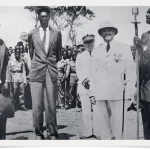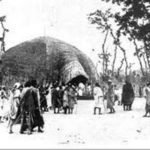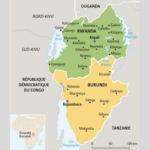The Umuganura Ritual of Rwanda: An Overview
In Rwanda of the late nineteenth century, the centralized political structure and hierarchialized administrative structures meant that in most areas of the country the influence of the central court was able to penetrate directly to the lowest level of society. Kingship was thus the preeminent factor in the political and social life of the country. As such, it was a constant preoccupation, philosophically as well as socially: needless to say, this focus on kingship was all the more intense at those levels of society that maintained direct contact with the court and with royalty.Within this context, the royal rituals in particular were oriented to the question of “What role has kingship?” But in addressing this question the rituals did not focus on kingship; instead, they examined the wider context within which kingship was located and sought to clarify the relationship of kingship with other aspects of ultimate concern: Ecology (in this sense of “Nature” or fertility, and hence also including food crops), Society, and Technology or “Culture”.
The terms “Society,” “Culture,” and “Ecology” are used here in ways that sometimes appear ambiguous. Thus within the umuganura ritual, food crops are sometimes seen to represent Nature and sometimes Culture. They are ambiguous in fact as well as in their symbolic roles, and their classification as symbols within the rites depends on the context and the oppositions in effect at any given time. Hence there is no consistent definition to the terms: since categorization can only be relative, the boundaries of these classifications can only be determined by context. In short, the categories are not determined by their con-tent but by the nature of their interrelation with other structurally equivalent categories. Because of this, in what follows the terms should always be read not as universally accepted concepts but rather as “What is meant by ‘Culture’ (or ‘Ecology’) in this context.”nology, Society) is present in each separate episode of the umuganura ritual, though within the different episodes the three may be structured differently in relation to each other. Kingship, according to the interpretation presented here, mediates between them. In this role kingship is analogous to Culture, which, both by definition and within the ritual, also mediates between Society and Ecology, between the human and natural domains. In certain respects, culture and kingship are therefore identified with—or reinforce—each other in the ritual. At the same time, however, there remains an ambiguous relationship of kingship with the wider concept of “culture.”
This structural paradigm is also reflected in other spheres (aside from action within the ritual itself). Geographically there appear (from the ritual itself and from other sources as well—in myth, historical traditions, and cultural differences between the two areas) two ritual domains of the kingdom, separated by the Nyabarongo River. North of the river, the region of Bumbogo—home of the primary ritualists of the umuganura ritual and also the location of the ritual planting and cultivation—represents the domain of Nature. All of the natural materials whose origin is prescribed in the ritual come from north of the Nyabarongo. Nduga, the area south of the river (which makes a large semicircular bend, thus partially defining the limits of Nduga) was the principal focus of the kingdom (and most common area for the localization of the royal court, despite the court’s frequent displacement). Finally, the Nyabarongo River was also an object of considerable ritual importance in its own right within the context of other rituals. For example, certain kings were (partially or totally) proscribed from crossing the river, and the ritual Code often prescribes an exact locality when it cites a passage across the Nyaborongo—as in traversing all ritual boundaries, this must be accomplished in the prescribed manner.
It will be seen that early in the ritual the passage of hoes and baskets (two material elements representing the domain of Culture ) mediates between the two geographical domains: Bumbogo, the domain of fertility and Nature, and Nduga, the focus of the kingdom and Society. In the later stages of the ritual, the sorghum harvest is transported in a specified type of basket (representing the work of man—Culture) by an unidentified “Hutu” (i.e., a nonroyal, in this context, and hence a generalized representation of Society at large), thus combining Ecology, Culture, and Society in traversing the two ritual/geographical domains and hence making them one. In the earlier stages of the ritual, therefore, Culture mediates between the two domains (representing Society and Nature); in the later stages all three elements of the triad join in unifying the two regions.
The balance of the two areas portrayed in the ritual goes beyond this, since there is also a ritual court in Bumbogo with all the trappings of the royal court in Nduga, thus helping also to tie the two domains by their common possession of a similar culture element, “kingship.” But while reflecting the royal court, the court in Bumbogo is in some ways also the inversion of the royal court in Nduga. The Bumbogo court, for example, is very small, and its size is emphasized in the ritual cultivation of the sorghum, where a tiny plot (of only one square meter) is first hoed; wider areas are cultivated later. In addition, this ritual cultivation is accomplished at night—an inversion of the normal pattern of work.Thus thetwo regions are both joined and differentiated by the common cultural element of kingship, and the transformations occurring in Bumbogo only serve to emphasize and reinforce the “proper” patterns of kingship in Nduga.
In myth, too, it is possible to discern the same tripartite categorization (with the same sliding of categories). First, several common myths relate the introduction of sorghum to Rwanda, to the travels of a famous royal culture hero, through the region of Bumbogo. According to different versions, either this king, while passing through Bumbogo, saw an ant carrying a grain of sorghum and brought it back to his people, or the king of Bumbogo sent sorghum to mediate a local dispute; in either case, the sorghum of Bumbogo was thereafter distributed to the people of Nduga. In both cases the Rwandan king is the intermediary between Bumbogo (Nature), sorghum (in this case, as a food crop, representing Culture), and the people of Rwanda (Society). Secondly, other widespread myths relate how the royal ancestors descended from the sky bringing with them iron, fire, and food crops to the people living in a “wild” state below; hence kingship is explicitly identified with important cultural items as mediators between the human and natural domains.
Therefore, the interpretation advanced here differs from the conventional interpretation, which emphasizes the ritual as reinforcing the linkages between the Tutsi rulers and the “peasant masses.” While the analysis presented here does not deny the existence nor importance of such class differences in Rwandan society, it looks at the significance of the ritual within a wider cultural perspective, in which the linkage problem seems only part of the concern of the ritual as a whole: broader questions were being addressed in the ritual as indicated both by the relatively passive roles of the ruling elite in the ritual and by the infrequent references to specific social groups (i.e to class divisions within society). In fact, as will be discussed below in greater detail, within the ritual the role of the rulers is portrayed as that of intermediaries within a wider cultural domain, while the focus of the ritual is on the polar extremes—the things to be related—rather than on the mechanism of this linkage (kingship), the significance of which remains implicit rather than directly declared.
What follows will analyze the ritual of umuganura—the annual First Fruits ceremony as it is portrayed in the esoteric Code of Rwandan royal ritual—in light of this structural paradigm. It will not be an exhaustive examination of the ethnographic data by any means, but what emerges will be sufficient, I hope, to articulate the nature and meaning of the ritual itself. To do this, I divide the ritual into six episodes; for each, the analysis describes the action and discusses the significance of the relations expressed in the episode
https://uk.amateka.net/the-umuganura-ritual-of-rwanda-an-overview/https://uk.amateka.net/wp-content/uploads/2023/12/kivu.pnghttps://uk.amateka.net/wp-content/uploads/2023/12/kivu-150x150.pngSocial & cultureIn Rwanda of the late nineteenth century, the centralized political structure and hierarchialized administrative structures meant that in most areas of the country the influence of the central court was able to penetrate directly to the lowest level of society. Kingship was thus the preeminent factor in the political...BarataBarata rpierre@ikaze.netAdministratorAMATEKA | HISTORY OF RWANDA



